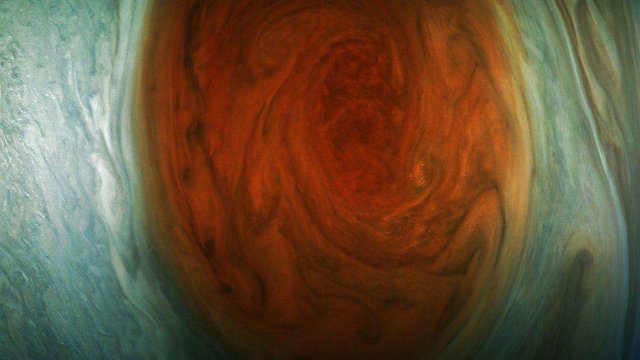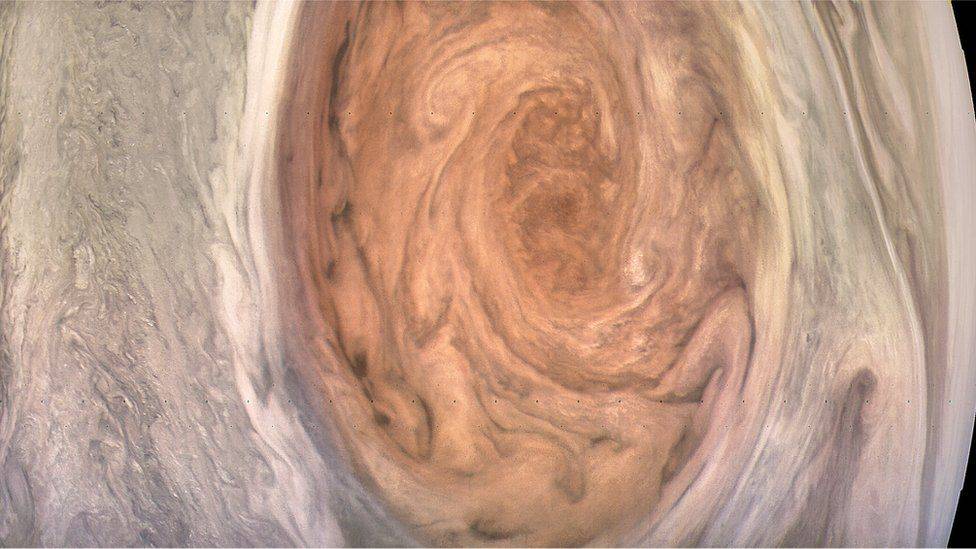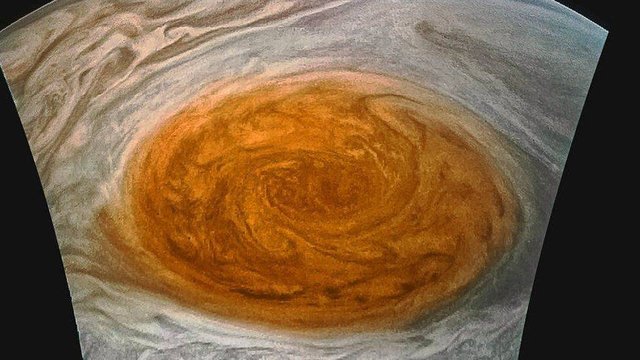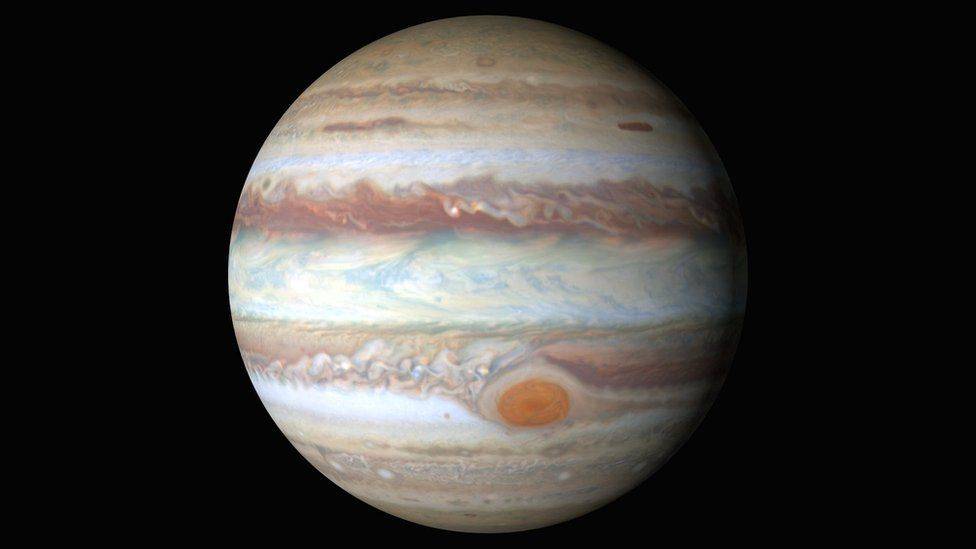Las increíbles imágenes en primer plano de la Gran Mancha Roja de Júpiter / The incredible close-up images of the Great Red Spot of Jupiter
La sonda Juno de la NASA se acercó para estudiar la inmensa y violenta tormenta que sacude al quinto planeta del Sistema Solar, lo que permitirá saber más de ella.

Esta semana la sonda espacial de la NASA Juno captó unas increíbles imágenes en primer plano por primera vez de la Gran Mancha Roja de Júpiter que se acaban de hacer públicas.
Lo que desde el espacio se ve como un gran punto de tonalidades naranjas y rojizas es en realidad una gigantesca tormenta.
Tal es su dimensión que hasta el adjetivo gigantesca se queda corto: tiene un tamaño que duplica al de la Tierra y sus vientos tumultuosos superan los 640 km/h.
Por qué la NASA decidió desviar por primera vez un asteroide que pasará cerca de la Tierra
Los ocho instrumentos de la sonda así como también la cámara JunoCam enfocaron hacia la mancha tomando unas imágenes que luego fueron procesadas por científicos para darles más nitidez y un mayor grado de detalle.

Las imágenes tomadas por Juno están disponibles para que los ciudadanos aficionados a la ciencia las procesen y les den una mayor calidad. Créditos: NASA/JPL-CALTECH/SWRI/MSSS/KEVIN GILL
La sonda -que viaja a unos 50 km por segundo- pasó a una distancia de unos 9.000 km del planeta y recogió información crucial para entender este fenómeno que astrónomos han estado observando desde principios del siglo XIX.
En infografía: Los nuevos planetas
El investigador principal de Juno en San Antonio, Texas, Scott Bolton, dijo que "durante cientos de años los científicos han estado observando, preguntándose y teorizando sobre la Gran Mancha Roja de Júpiter".
"Ahora tenemos las mejores imágenes de esta tormenta icónica. Nos tomará algún tiempo analizar todos los datos de JunoCam y de los ocho instrumentos científicos de Juno, para arrojar alguna nueva luz sobre el pasado, presente y futuro de la Gran Mancha Roja", aseguró, según un comunicado de la NASA.

Los ocho instrumentos de la sonda así como también la cámara JunoCam enfocaron hacia la mancha tomando imágenes como esta. Crédito: NASA/JPL-CALTECH/SWRI/MSSS/JASON MAJOR
La NASA informó que las últimas imágenes fueron editadas por "científicos ciudadanos" que tomaron las fotografías originales publicadas en la página web de JunoCam.
"Estas esperadas imágenes de la Gran Mancha Roja son una "tormenta perfecta" de arte y la ciencia.
Con datos anteriores de sondas y telescopios tenemos una mejor comprensión de la composición y evolución de este fenómeno icónico", dijo Jim Green, director de ciencia planetaria de la NASA.
Inmensa, antigua y en vías de achicarse
Las incógnitas que los investigadores buscan resolver en esta sexta vuelta que la sonda le da al planeta (la primera tuvo lugar el 27 de agosto del año pasado) son muchas.
Pero recordemos primero todo lo que se sabe sobre la Gran Mancha Roja:

¿Es ésta la misma tormenta que astrónomos observaron en 1600? Crédito: NASA
- Tiene un diámetro de 16.000 km.
- Tiene por lo menos 150 años, pero, posiblemente, varios siglos más.
- Las primeras observaciones datan de 1830. Sin embargo, astrónomos observaron hacia fines de 1600 una mancha roja sobre Júpiter que podría ser la misma tormenta.
- Es anticiclónica (es decir, gira en dirección contraria a la mayoría de las tormentas.
- Se está achicando: después de años de observación, la tormenta parece estar disminuyendo en tamaño.
Las incógnitas
Una de las grandes dudas es a qué le debe su color.
Según estudios, es muy probable que la atmósfera superior tenga nubes formadas por amoníaco, ácido sulfhídrico y agua.
Sin embargo, científicos desconocen si estos compuestos químicos reaccionan para darle este color.
Otra interrogante es por qué la tormenta continúa golpeando a Júpiter desde hace cientos de años.
Algunos científicos creen que se debe a que la tormenta tiene raíces profundas.
Por esta razón, investigar qué hay debajo de las nubes podría permitirles a los investigadores establecer si esto es así.
El próximo acercamiento de la sonda Juno a Júpiter ocurrirá el 1 de septiembre.
.
.
.
.
.
NASA's Juno spacecraft approached to study the immense and violent storm that shakes the fifth planet of the Solar System, which will allow to know more of her.

This week the NASA Juno spacecraft captured incredible close-up images of the Great Red Spot of Jupiter for the first time just being made public.
What from space is seen as a great point of orange and reddish shades is actually a gigantic storm.
Such is its dimension that even the gigantic adjective falls short: it has a size that doubles that of the Earth and its tumultuous winds exceed 640 km / h.
Why NASA decided to divert for the first time an asteroid that will pass near Earth
The eight instruments of the probe as well as the camera JunoCam focused towards the spot taking some images that were then processed by scientists to give them more clarity and a greater degree of detail.

The images taken by Juno are available so that the citizens of science can process them and give them a higher quality. Credits: NASA / JPL-CALTECH / SWRI / MSSS / KEVIN GILL
The spacecraft, which travels about 50 km per second, passed a distance of about 9,000 km from the planet and collected crucial information to understand this phenomenon that astronomers have been observing since the early nineteenth century.
In computer graphics: The new planets
Juno's principal investigator in San Antonio, Texas, Scott Bolton, said that "for hundreds of years scientists have been watching, wondering and theorizing about the Great Red Spot of Jupiter."
"We now have the best images of this iconic storm. It will take us some time to analyze all the data of JunoCam and the eight scientific instruments of Juno, to shed some new light on the past, present and future of the Great Red Spot," he said. , According to a NASA statement.

The eight instruments of the probe as well as the JunoCam camera focused towards the spot taking images like this. Credit: NASA / JPL-CALTECH / SWRI / MSSS / JASON MAJOR
NASA reported that the latest images were edited by "citizen scientists" who took the original photographs posted on the JunoCam website.
"These expected images of the Great Red Spot are a" perfect storm "of art and science.
With previous data from probes and telescopes we have a better understanding of the composition and evolution of this iconic phenomenon, "said Jim Green, director of planetary science at NASA.
Immense, old and in the process of shrinking
The unknowns that the researchers look for to solve in this sixth round that the probe gives to the planet (the first one took place the 27 of August of the last year) are many.
But let us first remember all that is known about the Great Red Spot:

Is this the same storm that astronomers observed in the 1600's? Credit: NASA
It has a diameter of 16,000 km.
It is at least 150 years old, but possibly several more centuries.
The first observations date back to 1830. However, astronomers observed by the late 1600s a red spot on Jupiter that could be the same storm.
It is anticyclonic (ie, rotates in the opposite direction to most storms.
It is shrinking: after years of observation, the storm seems to be shrinking in size.
The unknowns
One of the great doubts is to what its color owes.
According to studies, it is very likely that the upper atmosphere has clouds formed by ammonia, hydrogen sulfide and water.
However, scientists do not know if these chemicals react to give this color.
Another question is why the storm has been beating Jupiter for hundreds of years.
Some scientists believe it is because the storm has deep roots.
For this reason, investigating what is underneath the clouds could allow researchers to establish if this is so.
The next approach of the Juno spacecraft to Jupiter will occur on 1 September.
ESPERO QUE LES HALLA GUSTADO /// I HOPE YOU LIKED IT
¡Hola, @cesarx321!
Te invito a que te unas al chat Trail Hispano en Discord en donde podrás compartir tus posts y hablar con toda la comunidad.
Además puedes a unirte al Trail, el cual es un proyecto del chat en donde puedes recibir votos en tus posts. ¡Recibe alrededor de 80 votos en cada post y más según la gente se vaya uniendo!
Para unirte al trail, accede a https://trail.steemhispanos.chat. Para más información, te invito a que leas el siguiente post: Tutorial actualizado Trail hispano en Discord, herramientas y reglas 🙂
Para apoyarte en esta red, te comencé a segir
y he votado este post.
Nuevamente, te doy la bienvenida a Steemit y no dudes en contestar este comentario si tienes alguna duda.
me unire amigo gracias
me unire amigo
welcome to Steemit @Cesarx321! Nice post, i will follow your account, please follow me at @khunpoom
tanks, i will follow your account
Thanks friend, I'll follow you.
Welcome to Steemit @cesarx321, I have upvoted and sent you a tip. Check my blogs if you are looking for tips on how to earn more Steem and SBD.
tanks, i will follow your account
Thanks, I follow you.
WELCOME TO STEEMITI appreciate if you follow me,
Your comments are always welcome,
I will try to answer as much as possible,
Good luck with your trip in this communitas,
the best combination with all your friends is no exception,and upvote to your friends as much as possible,and the reverse.
Regards community steemit
Thank you
Thanks, I follow you.
Keep them coming! I can see that this is a recent account so I wanted to make this post. This post was nice so I upvoted it and keep on doing you!
As a newcomer to steemit, it's not easy getting those first upvotes so I suggest you to try out Steemfollower as you can earn 5x more steem than just upvoting by yourself! It's a simple and safe vote exchange that is free to use. I have also made this post where I explain the site in more depth and it has become my most upvoted post yet.